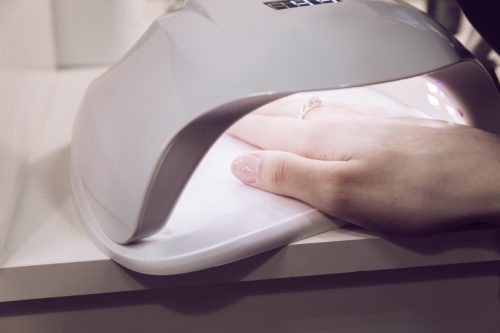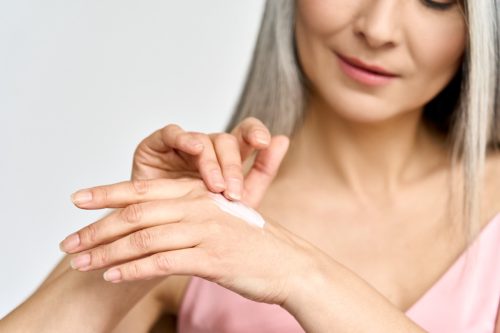
There’s no shortage of decisions when you’re getting a manicure: You have to select your color, the type of polish, whether you want acrylics, gel, or dip—the list goes on and on. These choices become more complicated with age, when you want something classic that still speaks to your personal style. Luckily, experts have tips and tricks to make your next salon trip a breeze, or to take into consideration when doing your nails at home. Read on to find out what they recommend for the perfect manicure after 60.
READ THIS NEXT: 5 Tips for Having Bangs Over 60, According to Stylists.
At the nail salon—or the drugstore, if you’re picking up supplies to do your own mani—there’s a wall of colors to choose from. This can be borderline overwhelming, especially if you didn’t go in with a plan for what you want. If you’re older, you might be inclined to reach for neutrals in lieu of bolder color options. However, Juli Russell, DIY nail expert for Sally Beauty, says these colors should actually inspire you.
“Bright polish colors are the best friend for mature hands. I used to paint my mother’s nails and was always surprised when she picked neon bubblegum pink for the color. As it turns out, she was onto something,” Russell tells Best Life. “Bright, even neon colors, make your hands look so much more youthful and even give the appearance of a warm sun-kissed glow to the skin.”
If hot pink sounds a bit too out there for you, Russell suggests reaching for a warm coral shade that can have a softer, but similar, effect.

Springing for unique colors is definitely an option, but you can stick to traditional looks or neutrals if they’re what you prefer. Russell says that you really “can’t go wrong” with a glossy red or a classic French manicure, both of which give off polished and confident vibes.
What you do need to avoid, however, are shades that will blend in with your skin. “Steer clear from sheer colors or hues that match your skin too closely, as this will give the dreaded ‘mannequin hands’ look,” Russell warns.
READ THIS NEXT: 5 Tips For Wearing Heels Over 65, According to Doctors and Style Experts.

There’s definitely variety when choosing the shape you want for your nails—including trendier options like stiletto nails, which have a sharp point, and ballerina nails, which resemble a pointe shoe. But before you start filing away or letting your nail tech know what you’re looking for, Russell says you should consider a more timeless shape after 60.
“Go for a classic—almond or oval shape—when shaping your nails for a manicure,” Russell says. “These two shapes are more youthful and lengthen the appearance of the fingers.”

If you’re a traditionalist, you might hold fast to standard nail polish. But experimenting with a gel manicure might be worth a try, according to Russell. “For mature hands, I would recommend gel,” she says. “The application and removal process is quick and easy.”
As a plus, with a gel manicure, you don’t have to wait for your nails to dry before leaving the salon. Thanks to a handy UV light that hardens the gel polish, your nails are ready to go as soon as that top coat is applied and cured.
When adding acrylics or doing a dip powder manicure—where your nails are dipped into colored powder and sealed with a clear coat—removal requires a longer soak in acetone, which Russell points out is also “harsh/drying for your skin.”
But if want to try a dip manicure, Russell says the risk might be worth the reward. You don’t have to be exposed to the UV light, and you’ll have a “gorgeous, glossy” manicure that lasts up to six weeks. “Just take caution to remove them properly and double up (or triple up) on hand cream application after you remove them,” she adds.
For more beauty advice delivered straight to your inbox, sign up for our daily newsletter.

You should be tending to your nails regularly, as they can lose a bit of their luster when you get older. “As we age, our nails can become more rigid and brittle,” Russell says. “You can combat this with two things: a ridge filler and a strengthener.”
A ridge filler is used instead of a base coat, helping to smooth out uneven nails. However, as board-certified dermatologist Dana Stern, MD, assistant clinical professor of Dermatology at the Mount Sinai Medical Center in New York City, told Byrdie, you need to be careful when selecting a ridge filler. Some can contain dangerous chemicals like formaldehyde and formalin, which can make your nails become more brittle or cause allergic reactions.
A nail strengthener is just that—a solution that strengthens your nails. Different varieties are available over-the-counter, but you can also opt to make your own solutions at home.
Lastly, protect your hands from the sun, as damage can lead to wrinkles. Your hands are exposed to sun throughout the day, so Russell recommends always applying a layer of sunscreen.


